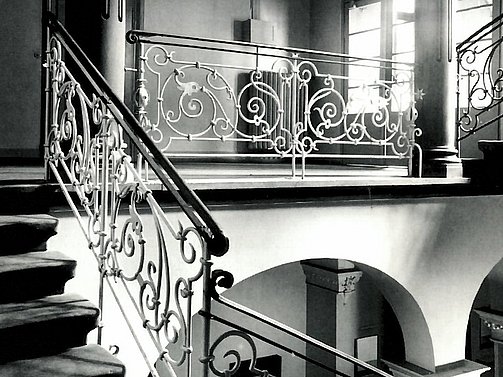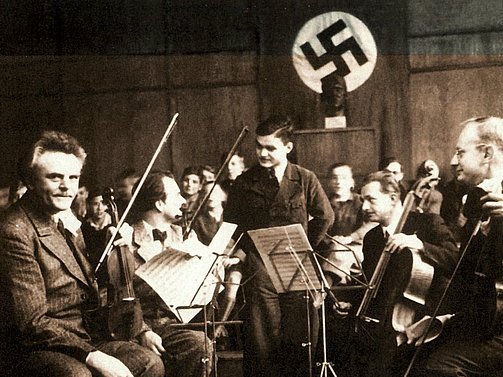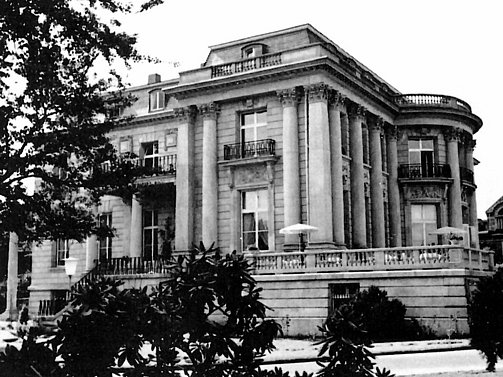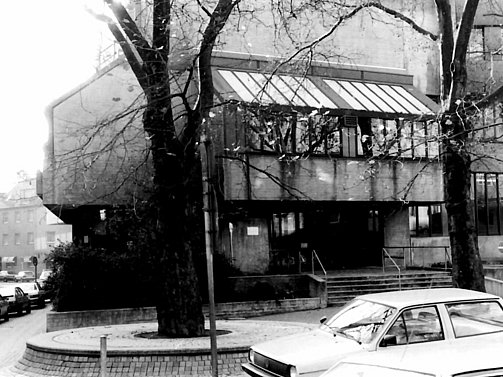History
Playfulness since 1845
From violin to contemporary dance, from the Rheinvilla to under the Krahnenbäume, with Kapell- and Oberbürgermeisters, from small overrooms to large concert halls, with numerous obstacles and successes. Here you will find the history of the Cologne University of Music and Dance.
1845
Founding of the first music school in Cologne financed by art-loving citizens of Cologne.
Prélude with piano, violin and voice.
In 1845, art-loving citizens of Cologne put up the seed money for Cologne's first music school in the form of ten talers a year. The idea for the foundation came from the conductor of the city theater, Heinrich Dorn. The city council and the music societies join in, and so begins the prelude to our present-day Cologne University of Music and Dance - at that time only for piano, violin, and solo and choral singing. Two years later it threatens to fall silent again. Because the already small number of nine students had shrunk to three.
Ferdinand Hiller, a student of Johann Nepomuk Hummel, realizes that this number is not enough for an orchestra, let alone a conservatory. He expands the curriculum and to the existing three subjects are added organs, cellos, composition, harmony, counterpoint and declamation. And so the college shines with new sound, splendor and rooms on April 4, 1850 at Marienplatz 6.
1850 - 1873: Crescendo across national borders.
In 1858, Felix Mendelssohn Bartholdy makes waves as far away as Cologne. His Leipzig Conservatory also inspires the "Musikalische Lehranstalt" to recompose itself into the "Conservatory of Music in Coeln. Its director, Ferdinand Hiller, also attracts many important talents such as Max Bruch and Engelbert Humperdinck to the city. And the conservatory is also talked about beyond the country's borders, from Holland, Belgium and England to North America and Australia.
The rapid growth is also favored by the move into a new building. After a brief guest appearance in Glockengasse and Marzellenstrasse, the Cologne Conservatory is finally able to move into its own building in Wolfsstrasse in 1873. The highlight: a concert hall complete with orchestra stage, in which more than 500 musical talents from all over the world make themselves heard around 1900.

1873 - 1925: Conservatory at the turn of the century.
Around the turn of the century, the conservatory initially gains in sound strength. Ferdinand Hiller is followed by the directors Franz Wüllner and Fritz Steinbach. They establish an opera, orchestra and choral school, preschool, conservatory and master classes, and an opera studio. In 1910, the dance department also begins to move tentatively: the subject of rhythmic gymnastics is introduced.
In 1914, the outbreak of World War I also affects the Cologne Conservatory. Many teachers and the majority of the administrative staff are called up for military service, and a large number of the students are also recruited. An uphill struggle for existence begins. During this time, the municipal music director Herrmann Abendroth takes over and manages to bring the number of students back up to 1,100 in the post-war year. After that, the inflation year of 1923 robs the funding basis. Finally, in 1925, a new beginning is made.
1925
Year of birth of the Cologne University of Music, which was the first institute to combine top-level and popular musical education.
Prelude to the whole.
Main instead of Rhine? When the university was reestablished in 1925, the choice of location initially oscillated between Cologne and Frankfurt. The mayor of the time, Konrad Adenauer, who would become the first chancellor of the Federal Republic of Germany a few years later, was a strong advocate of the Rhine metropolis. And so the "Hochschule für Musik" in Cologne opens its doors as the second Prussian music academy after Berlin.
The self-image with which the university distinguishes itself from the usual conservatory up to that time is retained to this day: one leg to play, one leg to stand on. For the insight began to take hold that a musical life only flourishes if attention is paid not only to the top of the pyramid - concert life - but always to the entire structure. Thus the Cologne University of Music - in the words of the music reformer Hermann Kretzschmar - "immerses every student with the broadest root in the organic whole of musical and artistic life."
1933 - 1945: The University under National Socialism.
In 1933, the educational ideas of the Nazi regime began to dominate the university. Musical modernism is fought against, Jewish and disliked artists are expelled, and the then director of the university, Walter Braunfels, is the first to be dismissed. In addition, all works by the so-called "half-Jew" Braunfels were banned. Hermann Abendroth, who was accused of "Jewishness," was also expelled from Cologne and was eventually transferred to Leipzig as Kapellmeister of the Gewandhaus. In 1935 Karl Hasse takes over as director of the Hochschule, and Hermann Unger is appointed as his deputy and as director of the Rheinische Musikschule.
After the outbreak of war in 1939, the students are ordered to perform "front concerts", and many teachers and students are drafted into military service. The repertoire is also restricted - Jewish and "degenerate" music may not be played. In addition, all Jewish teachers and students are excluded from the university by the Nazi regime. Among them - and among many others - the piano professors Heinz Jolles and Michael Wittels.
On the night of the bombing on June 29, 1943, the building in Wolfsstraße is destroyed. Fragmented and without central organization, teaching is difficult. Nevertheless, playing continues. In the last years of the war, instrumental and singing lessons take place partly in the private apartments of teachers.

After 1945: reconstruction and two guest performances.
After the end of the war, Konrad Adenauer reappointed Walter Braunfels as director of the Cologne Academy of Music. He was succeeded by Hans Mersmann in 1947.
Only slowly does the academy find its way back together. For the city of Cologne lies in ruins. Almost 80% of the city is destroyed by bombs. Still in the post-war turmoil, the university is divided into a municipal conservatory and the music academy, which is subordinate to the state of North Rhine-Westphalia. Both move to the place where French Rococo was revived on the Rhine: the Palais du Rhin, also known as Villa Oppenheim in Bayenthal.
The Palais proved to be only a brief interlude, however, because just a few years later the college finally stepped into the shoes of modern sound technology. In 1953, it moved into the old WDR broadcasting center on Dagobertstrasse.

1972
Three becomes one: connection of the conservatories in Aachen and Wuppertal.
Polyphony Under Crown Trees
In 1972, three becomes one. Or one becomes three. The previously independent conservatories in Aachen and Wuppertal join forces with Cologne to form the Rhineland State University of Music. With three locations, the motto for the next decades is to stand on its own two feet.
To this end, a new building is erected first. The Bauturm architects' association in Cologne designed the new building in the 1970s, and the university moved in in 1977. Thick concrete protects the outside world from sound and gives the inside world peace for concentrated practice. The amphitheater-like concert hall later becomes the model for the Cologne Philharmonic Hall and a well-known stage for young talents from all over the world. Because the new building stands on the same site as before, but faces the other direction, the address also changes. From now on, the university is located at Unter Krahnenbäumen 87.
At the end of the 1980s, a new law on art colleges came into force, giving the colleges greater responsibility and self-administration. With this, the long name journey of the university reaches its - almost - last station. From 1987 onwards, it is referred to as the "Cologne University of Music".
From 2009: Final with movement.
In 2009, the long-awaited movement begins. And that of the dance department. Dance had been taught at the Rheinische Musikschule since 1961 and was transferred to the university as an academic discipline in 1995. The fact that our university unites music and dance, musicians and dancers, symphonies and choreographies, finally becomes clearly visible with the new basic order of the university, the foundation of the Center for Contemporary Dance and a new name, from now on it is called: "Cologne University of Music and Dance".

An aftermath?
There is in any case. Because the story of our university is not over. In fact, we always start anew. By continuing and reinterpreting old music. By discovering and teaching new forms of music and dance. And welcoming many new faces every year to enrich us.